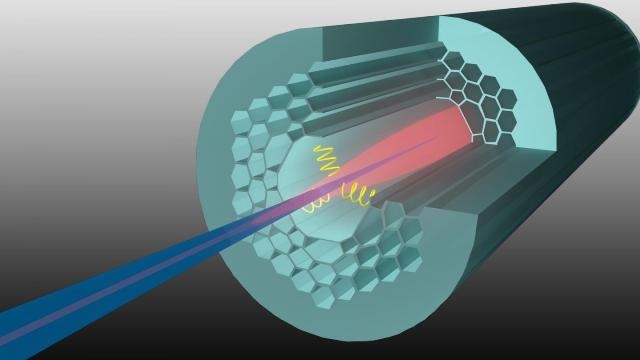Researchers have demonstrated, for the first time, that laser light can be used to manipulate a glass optical fiber tapered to a sharp point smaller than a speck of dust, in the middle of an optical fiber with a hollow core. Amazingly, optical forces cause the sharp point, or "nanospike," to self-align at the center of the hollow core, trapping it more and more strongly at the core center as the laser power increases.
 Simple, self-aligning method traps tiny tapered glass fiber inside hollow-core optical fiber, with potential applications in laser cutting and basic physics research. (credit: Philip Russell, director at the Max Planck Institute for the Science of Light in Erlangen, Germany)
Simple, self-aligning method traps tiny tapered glass fiber inside hollow-core optical fiber, with potential applications in laser cutting and basic physics research. (credit: Philip Russell, director at the Max Planck Institute for the Science of Light in Erlangen, Germany)
"Launching very high power laser light into an optical fiber, especially a hollow-core fiber, can be very difficult and usually requires extensive electronics and optics to maintain alignment," explained Philip Russell, director at the Max Planck Institute for the Science of Light in Erlangen, Germany, and leader of the research team. "This can be accomplished with our new system by simply pushing the nanospike into the hollow core and then turning up the laser power slowly. Once the nanospike self-stabilizes, you can turn up the laser power and nothing will move or get damaged."
In The Optical Society's high impact journal Optica, the researchers report that almost 90 percent of the laser light was transferred from the nanospike to the hollow-core fiber. The new work could increase applications for hollow-core fibers, a new class of fiber that features a hollow core rather than one made of glass like traditional optical fibers. Hollow-core fibers are especially good at handling high-power lasers, making them potentially useful for laser machining and cutting of metals, plastics, wood and other materials.
A sub-wavelength nanospike
To create the nanospike, the researchers started with an ordinary single-mode glass optical fiber about 100 microns in diameter. They heated this fiber so that they could stretch it to form a tapered portion and then etched the fiber's tip with hydrochloric acid to create a nanospike around 100 nanometers in diameter -- smaller than the wavelength of visible light -- and less than 1 millimeter long.
The researchers created the optical trap by inserting the nanospike into the hollow core fiber and launching a high-power 1064-nanometer laser beam into the single-mode fiber. When the laser light enters the tapered portion of the fiber it begins to spread out beyond the nanospike into the empty space inside the hollow core fiber. As the taper gets smaller and smaller, the light begins to sense the boundary of the larger fiber core, which causes the light to reflect inwards towards the tapered fiber. This reflected light exerts a mechanical force on the nanospike, forming an optical trap.
"The nanospike is held in place by the light at exactly the right place to perfectly launch the light into the hollow core without any electronics or other systems to keep it in place," Russell said. "If any of the components move a little, there's no effect on the laser light because the nanospike self-aligns and self-stabilizes."
New approach for studying optomechanics
In addition to efficiently coupling high-power laser light to hollow-core fibers, the new system offers an entirely new way to study the mechanical forces exerted by light, or optomechanics, especially at very low pressures. Scientists want to study optomechanical forces under high vacuum conditions but have been hampered by the fact that, for reasons not yet fully understood, particles tend to jump out of optical traps as air pressure is lowered from atmospheric levels.
"The beauty of the nanospike is that it behaves like a very small particle, but because it is firmly attached to a strong piece of fiber at one end, it isn't lost if it jumps out of the trap," said Russell. "This system allows us to measure forces that are almost impossible to measure in other systems, making it feasible to explore of an area of fundamental physics that isn't very well understood."
Source: http://www.osa.org/